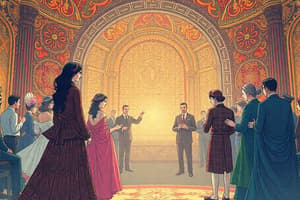Podcast
Questions and Answers
Which model emphasizes that political preferences are linked to group membership?
Which model emphasizes that political preferences are linked to group membership?
- Sociological model (correct)
- Rational choice model
- Psychological model
- Dominant ideology model
What has been the trend in class-based voting since the 1980s?
What has been the trend in class-based voting since the 1980s?
- It has diversified.
- It has remained steady.
- It has decreased. (correct)
- It has increased significantly.
What is the primary focus of the rational choice model?
What is the primary focus of the rational choice model?
- Class-based preferences
- Instrumental voting (correct)
- Identity voting
- Opinion leadership
Which model critiques the decision-making process of voters as influenced by elites and media?
Which model critiques the decision-making process of voters as influenced by elites and media?
What is a common characteristic of the psychological model?
What is a common characteristic of the psychological model?
What should voters evaluate according to the rational choice model?
What should voters evaluate according to the rational choice model?
Which concept refers to voting based on one's demographic characteristics?
Which concept refers to voting based on one's demographic characteristics?
What event marked the creation of the sociological model?
What event marked the creation of the sociological model?
What is a key characteristic of the party identification model?
What is a key characteristic of the party identification model?
Which of the following statements about partisan dealignment is true?
Which of the following statements about partisan dealignment is true?
What is indicated about family socialization in the party identification model?
What is indicated about family socialization in the party identification model?
Which period marked the beginning of empirical models in voting behavior research?
Which period marked the beginning of empirical models in voting behavior research?
What does the historical perspective on voting behavior indicate about the methods used before the interwar period?
What does the historical perspective on voting behavior indicate about the methods used before the interwar period?
In terms of stability, how does party identification compare to other political attitudes?
In terms of stability, how does party identification compare to other political attitudes?
Which factor is NOT directly associated with the party identification model?
Which factor is NOT directly associated with the party identification model?
Which model is seen as providing a better explanation for political preferences compared to the party identification model?
Which model is seen as providing a better explanation for political preferences compared to the party identification model?
What is the primary characteristic of direct democracy?
What is the primary characteristic of direct democracy?
How does representative democracy primarily differ from direct democracy?
How does representative democracy primarily differ from direct democracy?
What is a key aspect of participatory democracy?
What is a key aspect of participatory democracy?
What does egalitarian democracy aim to achieve?
What does egalitarian democracy aim to achieve?
Which event is credited with the birth of modern democracy?
Which event is credited with the birth of modern democracy?
Which term refers to the confusion caused by numerous proposed theories of democracy?
Which term refers to the confusion caused by numerous proposed theories of democracy?
What does plebiscitary democracy emphasize?
What does plebiscitary democracy emphasize?
Which of the following best describes medieval democracy?
Which of the following best describes medieval democracy?
Which definition best describes liberal democracy?
Which definition best describes liberal democracy?
What is a key feature of deliberative democracy?
What is a key feature of deliberative democracy?
What does majoritarian democracy primarily emphasize?
What does majoritarian democracy primarily emphasize?
In the context of consensus democracy, what is emphasized to enhance the democratic process?
In the context of consensus democracy, what is emphasized to enhance the democratic process?
What aspect does radical democracy focus on according to the definitions provided?
What aspect does radical democracy focus on according to the definitions provided?
In the context of economic democracy, what role does the political system play?
In the context of economic democracy, what role does the political system play?
What key characteristic defines procedural/minimal democracy?
What key characteristic defines procedural/minimal democracy?
Which statement best describes the relationship between economic inequalities and meritocratic democracy?
Which statement best describes the relationship between economic inequalities and meritocratic democracy?
Flashcards
Voting Behavior
Voting Behavior
The study of what motivates voters, who participates in politics, and what influences their political choices.
Party Identification Model (Michigan Model)
Party Identification Model (Michigan Model)
A model suggesting voters identify with a political party and tend to vote for that party consistently.
Partisan dealignment
Partisan dealignment
A decrease in voters' loyalty to political parties over time.
Family Socialization
Family Socialization
Signup and view all the flashcards
Empirical models
Empirical models
Signup and view all the flashcards
Political Preferences
Political Preferences
Signup and view all the flashcards
History of Voting Behavior Research
History of Voting Behavior Research
Signup and view all the flashcards
Political Participation
Political Participation
Signup and view all the flashcards
Columbia Model
Columbia Model
Signup and view all the flashcards
Class Dealignement
Class Dealignement
Signup and view all the flashcards
Rational Choice Model
Rational Choice Model
Signup and view all the flashcards
Issue Voting
Issue Voting
Signup and view all the flashcards
Dominant Ideology Model
Dominant Ideology Model
Signup and view all the flashcards
Psychological Model
Psychological Model
Signup and view all the flashcards
Opinion Leadership
Opinion Leadership
Signup and view all the flashcards
Identity Voting
Identity Voting
Signup and view all the flashcards
Classical Democracy
Classical Democracy
Signup and view all the flashcards
Medieval Democracy
Medieval Democracy
Signup and view all the flashcards
Direct Democracy
Direct Democracy
Signup and view all the flashcards
Representative Democracy
Representative Democracy
Signup and view all the flashcards
Participatory Democracy
Participatory Democracy
Signup and view all the flashcards
Egalitarian Democracy
Egalitarian Democracy
Signup and view all the flashcards
What are the key differences between direct and representative democracy?
What are the key differences between direct and representative democracy?
Signup and view all the flashcards
How does the concept of 'inclusion' change through history in relation to democracy?
How does the concept of 'inclusion' change through history in relation to democracy?
Signup and view all the flashcards
Meritocratic Democracy
Meritocratic Democracy
Signup and view all the flashcards
Economic Democracy
Economic Democracy
Signup and view all the flashcards
Liberal Democracy
Liberal Democracy
Signup and view all the flashcards
Procedural Democracy
Procedural Democracy
Signup and view all the flashcards
Deliberative Democracy
Deliberative Democracy
Signup and view all the flashcards
Radical Democracy
Radical Democracy
Signup and view all the flashcards
Consensus Democracy
Consensus Democracy
Signup and view all the flashcards
Majoritarian Democracy
Majoritarian Democracy
Signup and view all the flashcards
Study Notes
Voting Behavior - Comparative Politics
- Voting behavior is studied across different countries
- Core questions of the field:
- What motivates voters in political activities?
- Who participates politically, and who does not?
- What influences political preferences and choices?
- Findings are primarily relevant to democratic systems
History of Researching Voting Behavior
- Early research (before the interwar period) relied on deductive reasoning
- The interwar period saw collaborations between political science, economics, and behavioral sciences/marketing, resulting in empirical models.
- Psychological research gained prominence in the 1990s
Party Identification Model (Michigan Model)
- Developed at the University of Michigan in the 1950s (The American Voter, 1960)
- Key figures: Angus Campbell, Philip Converse, and colleagues
- Voters identify with a party and vote for it regardless of circumstances.
- No rational or emotional reason to switch parties.
- Party identification is more stable than other political attitudes but less stable than attitudes like religious beliefs.
Potential Dynamics of the Michigan Model
- Family and early political experiences influence party identification (intermediate effect)
- Heavily based on US political characteristics
Partisan Dealement
- Data shows partisan voter percentages and annual change in various countries.
- Percentage of partisan voters has decreased in many democracies since the 1960s and 1970s
- Several countries display a tendency toward dealignment
Types of Parties and Partisanship
- Graphs show the change in vote share for mainstream left, mainstream right, challenger left, challenger right and challenger green parties over time
Sociological Model (Columbia Model)
- Developed at Columbia University in the 1940s
- Key figures: Lazarsfeld, Berelson, and colleagues
- Links political preferences/actions with group membership
- Social groups tend to be politically homogenous
Potential Dynamics of the Sociological Model
- Group interests drive political interests
- Opinion leaders influence political views
- Identity voting
- Voting based on external features
Class Dealement
- Class-based voting has declined since the 1980s
- New groups are emerging
Rational Choice Model
- Developed in the interwar period, primarily by economists
- Key figures: Hotelling, Downs, and others
- Instrumental voting: voting to further one's interests
- Issue voting: voting linked to specific policy issues
Potential Dynamics of the Rational Choice Model
- Voters have clear, consistent preferences (at least on key issues)
- Voters evaluate political performance and policy platforms
- Voters choose options/actions that maximize their self-interests
- Identity voting
- Voting based on external features
- Historical spending data from different policy areas in countries is presented for reference.
Dominant Ideology Model
- Developed in the 1970s as a critical model
- Critiques other previous models
- Voters do not make decisions with freedom, they are influenced by elites and the media.
- Subconscious decisions and interpreting viewpoints through communication are emphasized.
Psychological Model
- Developed in the 1990s
- Key figures: Marcus, Taber, and others
- Diverse models exist with differing premises
- Emotional and subconscious factors influence voting decisions, that are later rationalized.
Dynamics of the Psychological Model
- Political campaigns, events lead to emotional reactions, often stronger than rational thought
- Voters' actions/inactions, shifts in preferences are fueled by emotional responses
- Rational or group-based motivators are almost irrelevant
Studying That Suits You
Use AI to generate personalized quizzes and flashcards to suit your learning preferences.




